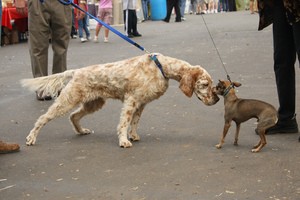 How often are we unhappy about certain behaviors our dogs have? Like jumping up on strangers when they first meet them, barking all the time, growling at other dogs, the list goes on and on.
How often are we unhappy about certain behaviors our dogs have? Like jumping up on strangers when they first meet them, barking all the time, growling at other dogs, the list goes on and on.
What do we do in these cases?
Most of the time, we will express our frustration in one way or another. “No.” or “Don’t do that!” is probably the word or expression most often used.
Often, we get frustrated (or even angry) if the “No” does not get the desired result. But are we the only frustrated ones? How is all of this for our dogs?
How To Communicate With Your Dog
Most of the time, our dogs really don’t even know what we are talking about.
Oddly enough, by our expression of what we don’t want them to do, we actually project exactly that onto them!
As an example, what happens when I tell you not to think about your front door? What do you immediately do? Think about your front door, right? Even if it was just for a second.
Well, your dog does the same thing. You tell him what not to do and the message he gets is to do exactly that! On top of that, we don’t let him know what we are asking for! So we yell at him with the message of what not to do — which to him is actually what to do. (“Don’t bark” to him means “bark”.)
So, from your dog’s point-of-view, he is doing exactly what you are asking him to do. However, you are getting more and more frustrated (and he perceives that too), but he does not know why — because he is barking like you are asking him to!
Interestingly, from your dog’s point-of-view he thinks you must be getting more and more frustrated about whatever he’s barking about, so he will bark more to get whatever that frustrating thing is to leave!
See where this is going?
By now, you might be so frustrated that you will harshly correct your dog. And the end result is your dog is utterly confused!
How To Create A Different Result
It’s actually quite simple. Tell your dog exactly what you are asking him to do. That way, you are giving him a job to do!
For example, to keep with the barking theme, tell your dog exactly what the job is: “Thank you for alerting me to the noise you are hearing. Once I acknowledge it, you need to be quiet.”
That would be a job description. The next time when your dog barks, you say, “Thank you. I got it. I saw the person walking by. Be quiet now.” And if he quiets down right away, give him a treat. (Or make him sit and give him a treat, or his favorite toy.) This works great — especially if in the past you have had long episodes of barking, and this time he quieted down really fast!
 Another job description might be: “I need you to be friendly when we see another dog. When we leave the house I need you to be friendly with all dogs and people.” Again, when you are about to meet another dog say, “Friendly!” That is the basic idea.
Another job description might be: “I need you to be friendly when we see another dog. When we leave the house I need you to be friendly with all dogs and people.” Again, when you are about to meet another dog say, “Friendly!” That is the basic idea.
The more you project exactly how you would like things to look and you start to guide your dog through the steps, the more your dog will actually be doing what you are asking. After all, remember that your dog wants to do what you are asking. He is always looking to please you!
So if you see yourself more like a guide, a director for your dog, you will be more likely to encourage the behavior that you want your dog to do. Remember, your dog did not come into this world knowing the rules and way of life that people have created. He has to be shown. So help him out by telling him.
…Have you given your dog a job lately?



